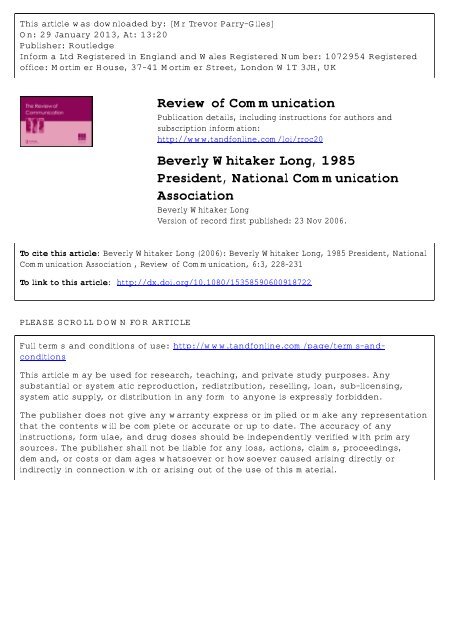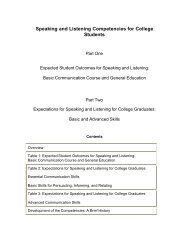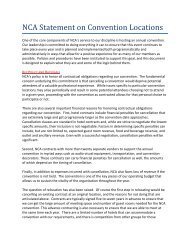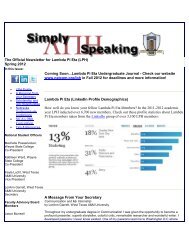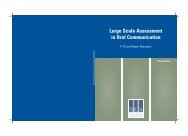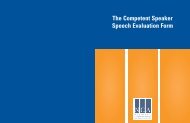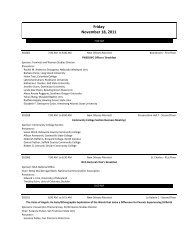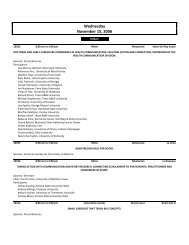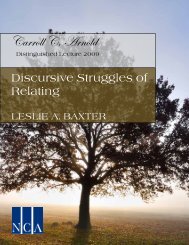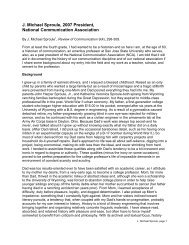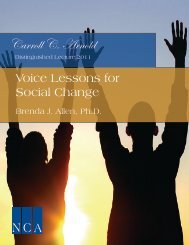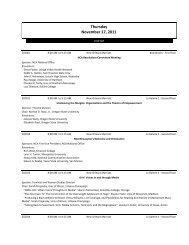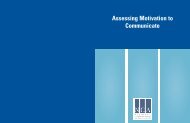Beverly Whitaker Long, 1985 - National Communication Association
Beverly Whitaker Long, 1985 - National Communication Association
Beverly Whitaker Long, 1985 - National Communication Association
Create successful ePaper yourself
Turn your PDF publications into a flip-book with our unique Google optimized e-Paper software.
230 B. W. <strong>Long</strong>Downloaded by [Mr Trevor Parry-Giles] at 13:20 29 January 2013I took four of them and left armed with exciting and invaluable tools that wouldevolve later into theories of describing and evaluating literary works and literature inperformance.In my first college teaching at Southwest Texas State in San Marcos, I encounteredtwo more nurturing male administrators, Elton Abernathy, department chair, andJim Barton, director of the theatre. I was hired to costume four major productions ayear, direct children’s theatre, teach introduction to speech (four sections eachsemester) and oral interpretation, and if I were lucky, team up to teach aninterdisciplinary theatre appreciation class. I never learned so much as I did workingwith Elton and Jim and also with faculty from a wide variety of disciplines, anassociation made possible by the size of the institution. Perhaps the major discoveryof this period was my realizing that although I was committed to performance, thetexts I was most attracted to were poems and narrative. From that point on, I wasfocused on the performance of literature.At LSU and at San Marcos I discovered the pleasure and power of my womencolleagues. I’m not sure I’ve ever made a professional decision without discussing itwith Mary Frances Hopkins and Gresdna Doty (and later, Mary Strine). They were*and are*collaborators, questioners, enablers. Never pushy or judgmental, theyprofoundly affected my thinking and my practices. I learned from them what‘‘feminist,’’ in its richest sense, meant.While at San Marcos, I attended my first professional convention, the Texas Speech<strong>Association</strong> in Galveston. It was fun and I got to see Robert and Gertrude Breenperform ‘‘Miss Brill,’’ in a style they called Chamber Theatre. The next year I tookstudents to the Southern Speech Convention in North Carolina. In 1966 I attendedthe <strong>National</strong> Convention of Teachers of English, and, in 1967 my first SCAconvention, where I delivered a paper on aesthetic distance. Since that time, I’vemissed few Southern conventions (serving as president in 1975) and no nationalones. The conventions were always energizing and often inspirational.In 1968 I met Bob Jeffrey, new chair of the Department of Speech at the Universityof Texas. He was my boss, adviser, soul mate, friend, even cast member. He knew howto get things done, and he knew what was worth doing. He was open, kind shrewd,and visionary. And he generously shared his wisdom, making him a mentor of thehighest order. He (and his wife, Phillis) encouraged, advised, even pushed, my workin SCA. He was on the nominating committee (along with Dennis Gouran) thatasked me to be a candidate for the <strong>1985</strong> presidency.By that time, I had left the University of Texas to be with my husband, Bill <strong>Long</strong>.Some colleagues were amazed that I could give up a professorship at UT and move toIndiana. I loved Texas but there was no contest. In 1977 Bill took early retirement, adecision that coincided with my being offered a job at the University of NorthCarolina at Chapel Hill. I thought I was going there to be a full-time teacher/researcher, but what the department needed was a chair and I was the most likelycandidate. Most of the faculty were much younger than I, so it was challenging andrewarding to support them in building their professional careers.
<strong>Beverly</strong> <strong>Whitaker</strong> <strong>Long</strong> 231Downloaded by [Mr Trevor Parry-Giles] at 13:20 29 January 2013In SCA, I served on all sorts of committees, first in the Interpretation Division andlater in <strong>Association</strong> appointments. My induction into the Administrative Committeewas as a member and then chair of the Research Committee, where I watched,admired, and learned from Karlyn Kohrs Campbell.When I was elected Second Vice President, candidates did not ‘‘run’’ in the sensethey do today. There were no regional convention appearances, no speeches; in fact, itwas expected that one would not even seem to be campaigning. I doubted that Iwould win because I was a woman and neither educated nor employed in a Big Tenschool. I did, however, have support from a variety of places: Texas, where I hadtaught at two institutions and served as an officer in the State association; theSouthern region, where I had been very active; in the Interpretation Division; andamong women. My opponent was Jim Andrews from Indiana University, a charmingman whom I only recently met. Somewhat ironically, this (Fe)mentoring project ledme to him because he once taught with Magdeline Kramer, the subject of my essay.During my tenure on the Committee on Committees, with its frequentopportunities to make appointments, I worked to increase the presence of women.I also worked to increase the visibility of the arts-performance-literature tracks of the<strong>Association</strong>. I wanted performance to be mainstream, or at least respected, notmarginalized. My chief effort was directed toward the creation of a new journal,which happened eventually with the substantive contributions of Bob Jeffrey, MaryFrances Hopkins, Jim McBath, and Kathleen Jamieson.Another of my goals was to recognize teaching in a manner similar to the way wealready recognized scholarship. To that end, I asked Jody Nyquist and Mary MargaretRoberts to create the first ‘‘Teachers on Teaching’’ programs. Also, I re-instituted the‘‘past presidents’’ gathering (after a period of financial austerity) because I thoughtthe <strong>Association</strong> and the <strong>National</strong> Office would be more secure when this group ofcommitted former leaders knew each other and met annually. I also initiated a TaskForce on Related Organizations, which, for a time, established contact with otherprofessional organizations primarily through convention program exchanges.During my presidential year, I spent a good deal of time trying to assist in ‘‘holdingthings together’’ in the <strong>National</strong> Office where there was illness, confusion, shortage ofmoney, and general unease. I was helped greatly by my colleagues at the University ofNorth Carolina who worked on <strong>Association</strong> matters and, more importantly, gave methe opportunity to practice leadership by chairing the department. I was blessed by anabundance of help from my husband, Bill. A retired IBM manager, he not only madecoming home a joy but he also made work better with his calm listening and astutecommentary on whatever the issues at hand.My general sense, when I left the SCA office, was that I had helped make somethinggood a little better, and I felt good about that.Note[1] At the time of <strong>Long</strong>’s presidency, the <strong>Association</strong> was known as the Speech <strong>Communication</strong><strong>Association</strong>.


